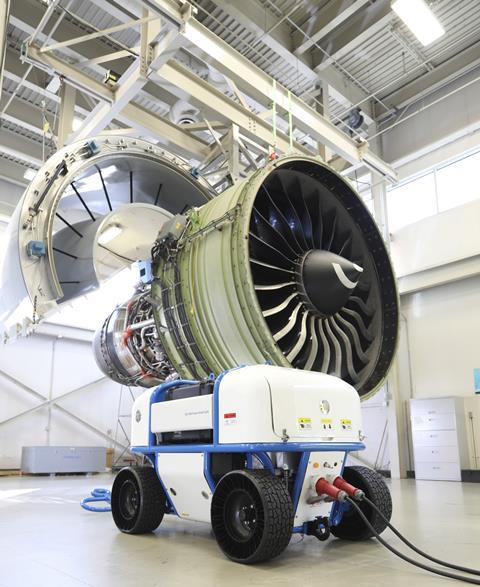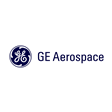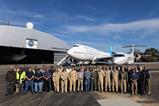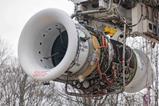GE’s 360 Foam Wash is a proprietary foam detergent with more jet engine cleaning capability than traditional water wash. The deeper clean helps restore engine performance, leading to improved fuel efficiency. First tested with customers in the Middle East, 360 Foam Wash is now more widely available. Learn more.
If there’s one thing airlines chase more than anything else when it comes to engines, it’s “time on wing.” The longer you can keep a jet engine in good working order without having to remove it for maintenance, the more flights you can complete and customers you can serve.
In the Middle East in particular, airlines fight a constant battle to increase time on wing. Sand can adhere to the turbine blades inside an engine and work its way into the compressor, wreaking havoc on fuel efficiency, a metric closely linked to CO2 emissions. Now, after a lot of study and testing, GE engineers who designed and built those engines think they’ve hit upon a novel way to reverse the effects of the sands of time. Called GE’s 360 Foam Wash, the powerful approach thoroughly cleans a commercial jet engine, helping to improve its performance and potentially eliminate tons of climate-damaging CO2.
“The process of water washing engines has not fundamentally changed in the last three decades,” says Mike Eriksen, senior technology leader of Maintenance, Repair and Overhaul (MRO) services at GE Aerospace. “The process is literally spraying water or detergent into the engine inlet while the engine’s motoring and rinsing it out. This was not adequate for modern cleaning needs, so we reinvented how to clean an engine.”
GE’s 360 Foam Wash is now approved for use on engines including the GE90, GEnx and CF34. At the 2021 Dubai Airshow, GE Aerospace announced the 360 Foam Wash program has reached 1,000 washes of engines in the field since 2017. So far, seven airlines and one MRO operator have license agreements.
When compared to cleaning jet engines with water wash, foam wash can save an estimated 15,900 gallons of fuel and 168 tons of CO2 emissions per year on a GEnx-powered Boeing 787 aircraft.* With a GE90-powered Boeing 777, foam wash has the potential to save an estimated 35,500 gallons of fuel and 377 tons of CO2 emissions per year compared to GE90 engines cleaned with water wash**.

The hunt for a cleaning solution started around 2012, when GE started noticing what it called the “hot and harsh” effects of sand on the wide-body jets flown by some of its engine customers, Eriksen recalls. Emirates airline — and, later, Etihad Airways and Qatar Airways — came to GE with the same problem: Very fine particulate dust was getting “baked on” to the cores of the GE90 and GEnx engines, causing a loss in fuel efficiency. Traditional water-wash techniques were showing diminishing returns — they couldn’t keep engines clean enough between regularly scheduled maintenance sessions. The relentless desert heat and sand were exacting a toll.
After studying the problem at GE’s Middle East Technology Center in Dubai, GE Aerospace took the data to GE’s Research Center (GRC) in Niskayuna, New York, where Eriksen says they posed two key questions: “How would you characterize the dust that we’re seeing? And how would you remove it?”
A geologist at GRC subjected the samples to a battery of tests and found it to be “a very hard, metamorphically phase-reacted layer of dust,” Eriksen says. “The dust is very hard to the touch, like cement.” GE engines are otherwise very efficient at ingesting and separating coarse gravel, rocks and sand that occasionally find their way into the inlet. “But the really fine dust, we found, still went through the entire core,” he says. “That’s what was building up.”
That’s when the real brainstorming began. Over the next couple of years, the technicians at GRC developed what Eriksen describes as a “really novel detergent” that is extremely effective at breaking down the binders in that hardened layer of dust. But once they had the detergent, he says, the team had another challenge: how to carefully inject it into an engine.
This is where the foam came in. As Eriksen says, “foam is just a volume-filling method. It enables us to keep the detergent in contact with the flowpath surfaces for a prolonged time to allow the chemical reaction to loosen the dust.”
They built three generations of prototypes for the foaming system and a mock-up of an engine in the lab so that they could figure out how to safely and effectively distribute the detergent throughout its core. Once they had the foaming system fine-tuned, they took it to some of GE Aerospace’s overhaul shops and tried it on various engines that were being repaired. After using the foam wash, they’d run the engine in a test cell to measure its recovery — basically, how hot it gets when it’s running. “If the exhaust gas temperature (EGT) is within a certain range, you know that the engine is running efficiently,” Eriksen says. “When there’s dust buildup, if the engine has to work harder and use more fuel to produce the same amount of thrust, that’s what increases the EGT.”
While a normal water wash typically produces a fall in EGT as the engine becomes more efficient, the foam washes were resulting in “significant” drops, he says. “We started seeing the EGT recovery and the fuel flow recovery go off the charts.”
By 2017 they were ready to take it into the field. Etihad began testing 360 Foam Wash on-wing on a GE90 engine powering a Boeing 777 that January; Qatar followed in April, testing it on a GEnx-1B engine designed for Boeing 787 jets. Over the next four years, working with their partners at Etihad, Qatar and Emirates, GE Aerospace industrialized its foam wash system, designing a special self-contained cart with hoses to pump the detergent into an engine and a separate apron to catch the solution as it flows out. The cart allows 360 Foam Wash to be employed in a variety of on- and off-wing scenarios, whether inside a maintenance hangar or outdoors on a tarmac.
Air India, Emirates, Etihad Airways, Japan Airlines, Qatar Airways, Royal Jordanian Airlines and Saudi Arabian Airlines now hold technical licenses to use 360 Foam Wash for their GEnx, GE90 and CF34 engines.
GE continues to work in a variety of ways to help its airline customers incorporate more emissions-lowering methods into their businesses.
*Estimates for GEnx fuel savings based on 650 cycles a year, with each cycle lasting six hours on a two-engine Boeing 787 Dreamliner operating in the Middle East.
** Estimates for GE90 fuel savings based on 700 cycles a year, with each cycle lasting 6.5 hours on a two-engine Boeing 777 operating in the Middle East.































